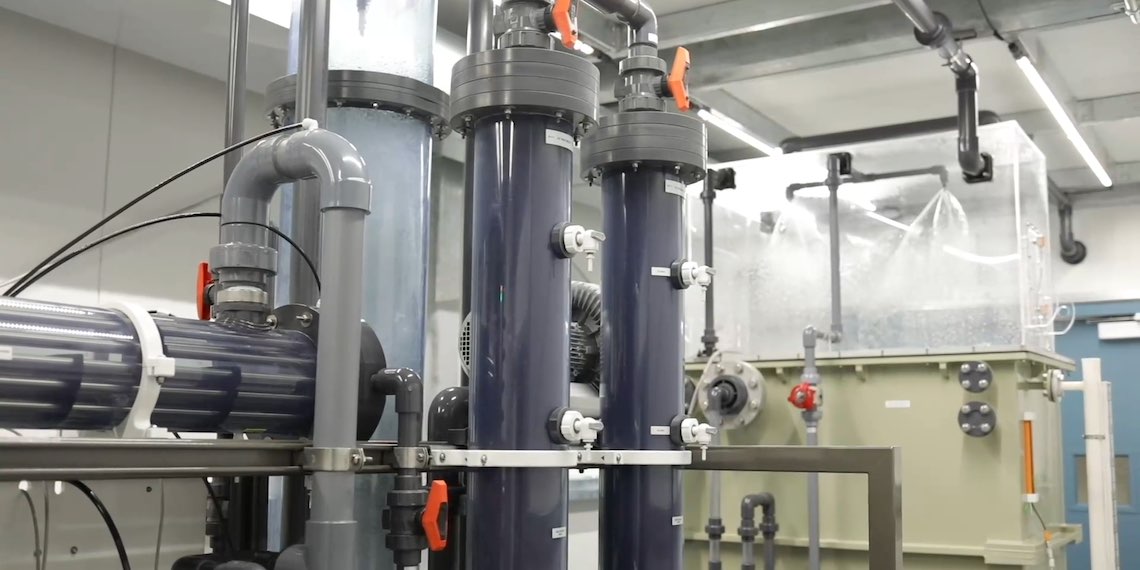Safer and more energy efficient Australian technology to clean up PFAS contamination

Australia is the site of a new initiative to remove per- and polyfluoroalkyl substances — known as PFAS — from contaminated liquids without generating hazardous by-products.
The DE-FLUORO process, developed by AECOM, uses an electrochemical oxidation process, rather than traditional methods of filtering or intense heat.
“Electrochemical oxidation is a process that's used in lots of different industries — the process is therefore not new and it's been around for a long time. But to use that application in PFAS destruction had never really been thought about,” said Gavin Scherer, AECOM’s Global PFAS Commercialisation Leader.
“Our teams worked with our partners to look at this from a series of different areas, including using different types of electrodes, which resulted in the development and application of a proprietary electrode.”
Although AECOM teams from around the world participated in developing the technology, closer to home the technology development was led by Rachel Casson, the Sydney-based director of the company’s PFAS program, and Australia is the site of its initial rollout.
“Australia was such a pivotal part of this program because this is where all the work was happening,” Scherer said.
“The Australian Defence Force was undertaking a lot of pivotal work in relation to PFAS [and] that was leading to regulations from the EPA coming into play.”
Real-world tests
Initially, AECOM’s trials consisted of spike samples in the lab, but in 2019 they shifted to real-world tests. The Australian demonstration of the technology concluded in 2021.
“We received eight different samples from industry of various types of PFAS impacts from low-concentration groundwater, all the way up to ... 3M’s Light Water, which contained a huge amount of PFAS,” Scherer said.
“So we undertook our demonstrations of our real-world testing, and we showed that we could actually destroy that PFAS very effectively within a very short period of time.
“That led to us building the systems that we have at the moment: our batch system, which is in Australia and our flow-through system, which is in the US.”
AECOM’s large-scale field demonstration trial focused on treating used wash water and AFFF — or aqueous film-forming foam concentrate, a product used for fire-fighting — from an infrastructure cleaning program.
“This is where you take tanks that used to contain AFFF, remove the AFFF, wash the tanks out and take the wash water and treat that effectively,” Scherer said.
“Our results showed that we had reached the site's discharge limits within around eight to 10 hours, which was really fantastic for us. Now we could continue to treat that material as a closed-loop approach and take that down to zero.”
Another advantage of AECOM’s technology is that it uses much less energy than other approaches.
“Incineration requires a huge amount of energy to burn up to those temperatures,” Scherer said. “These [DE-FLUORO] units are working off around 3.5 kWh to 5 kWh, so their energy consumption is minor.
“What we've been able to find is that we're dealing with dollars a day of energy in terms of treatment, and we also have found through this process that we can use solar applications on these — using solar with battery support, obviously, to build up that energy and use that energy for consumption.”
According to AECOM, several industries have shown an interest in using the technology, from government in both Australia and the US to many more in the private sector.
“Government, including military sectors which have a history of using PFAS, are very much interested in this,” Scherer said. “Those clients are undertaking programs where they're washing out infrastructure, they're undertaking programs where they're needing to remove stockpiled wastes of AFFF as well as other PFAS impacted liquids.”
The oil and gas industry is also interested, as are businesses that deal with industrial wastewater.
“The oil and gas majors have a variety of waste streams — generally AFFF — and they are cleaning out infrastructure as well,” Scherer said. “Aviation of course, with all their fire-training activities and then industrial uses, which we see coming more into play very shortly.”
Next steps
The next step for AECOM is to continue deploying DE-FLUORO systems in Australia and overseas.
“Our commercial programs have started within Australia in both the evaluation and the onsite treatment,” Scherer said.
“We're hoping [that] over the next 12 months, we will have many of these systems out — not only within Australia and the US, but we are also working on a program in Europe at the moment as well, where we have our evaluation systems there too."
AECOM is also developing what it calls “bench” systems.
“These are one-sixth the size of the systems that we've got, so they’re still big, but they're evaluation ones,” Scherer explained.
“That means we can go to our clients and say, ‘Hey, if you're interested in DE-FLUORO, you don't actually have to have the full system put on the site to test it. We can run some liquid through our evaluation systems and give you the outcome or give you the results to decide if this is something you want to take forward."
And even though the technology is going global, Australia remains at the forefront.
“The first steps are always coming from here, which is really a wonderful achievement,” Scherer said.
“When you think about the size of our market compared to the global markets and the fact that people are watching what we are doing, it's really a proving ground for DE-FLUORO here.”
